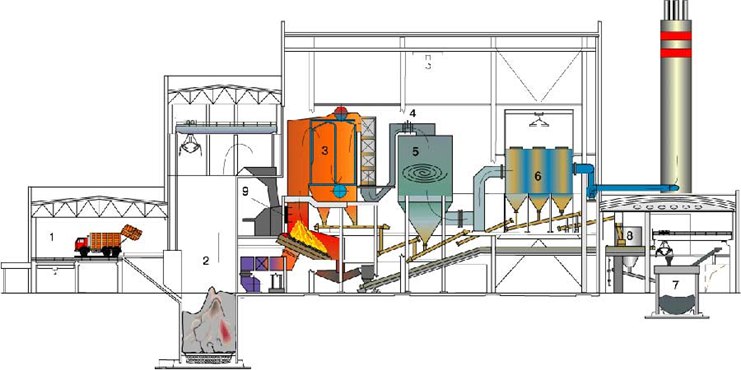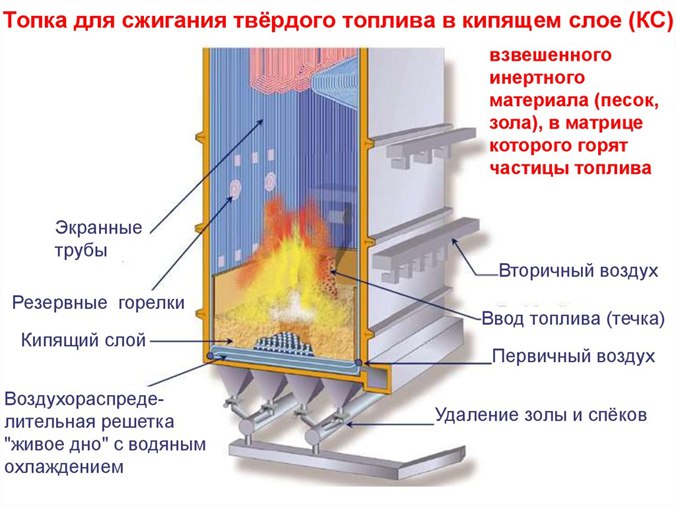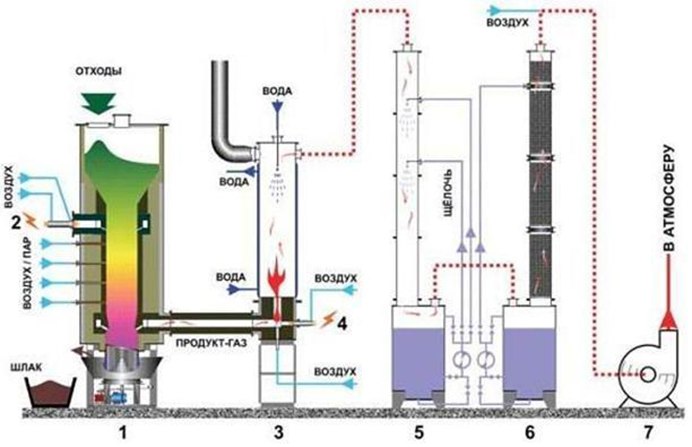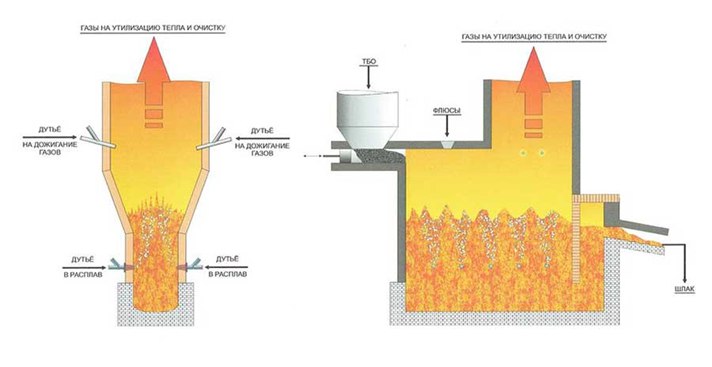Сontent
- Introduction
- 1. Relevance of the topic
- 2. Requirements for boiler equipment
- 3. Methods of MSW incineration
- 3.1 Waste incineration technology in mechanical grate furnaces
- 3.2 Waste incineration technology in mechanical fluidized bed furnaces
- 3.3 Gasification of MSW
- 3.4 Technology of high-temperature processing of MSW in melted slag
- 4. Advantages and disadvantages of MSW incineration
- Сonclusion
- List of sources
Introduction
In the process of evolution of boilers, the technical requirements imposed on them also changed. At present, to boiler plants, incinerators have the following requirements: gaseous products of combustion in the boiler at a temperature of more than 850 ° C in for two seconds or more; organization of the combustion process in such a way that so that the concentration of products of incomplete combustion (mainly carbon monoxide CO) in flue gases did not exceed 50 mg/m3 (in recalculated for 11% oxygen concentration), and the content of combustibles in the slag was no more than 3%; use of an automated system management of the combustion process, including continuous monitoring; the possibility of incinerating waste with a wide range of calorific values MSW at the lowest specific cost associated with the use additional fuel and electricity.
1. Relvance of the topic
Currently, the problem of recycling is quite serious. municipal solid waste. In many countries of the world this problem is solved with by sorting waste directly by the public in front of it transportation for processing. In our region, separation issues waste by groups are still quite complex.
Technology of thermal processing of municipal solid waste (MSW) has evolved from small-capacity furnaces without heat recovery with primitive purification of combustion products from solid particles to powerful modern environmentally friendly installations that allow generate heat and electricity.
2. Requirements for boiler equipment
Depending on the specific composition of MSW, boilers may additional requirements, for example:
-The temperature limit at the inlet to convective surfaces is not more than 750°C according to the conditions of minimizing the slagging of these surfaces;
-Limiting the speed of gases in convective heating surfaces up to 5 m/s, due to the high abrasiveness of the ash; use of the working environment with low steam parameters (pressure - 1.3 -4.0 MPa, overheating temperature - 300 - 400°C) to prevent high temperature corrosion superheaters (when burning waste with a high content of chlorine and fluorine);
-High flue gas temperature at the outlet of the boiler (190°С and above) to exclude low-temperature corrosion of tail heating surfaces (for high-sulfur MSW).
3. Methods of MSW incineration
3.1 Waste incineration technology in mechanical grate ovens
Initially, garbage trucks dump waste into a storage bin, where it sorted, crushed, compacted and processed special forces. From there, MSW enters the furnace and burns on the grate grate at a temperature of 600-1300 degrees.
Combustion products are screened into the lower chamber of the boiler, leaving smoke gases are sent upwards to the waste heat boiler and filter system. Further ash and slags are purified from heavy metals, and the resulting products are used as filler in road construction. As for the departing flue gases after the combustion process, then initially they come through waste heat boiler that uses the thermal energy of flue gases for heating network water, isothermal oil or obtaining saturated/superheated steam. It then goes through an electrostatic fly ash filter and bag filter system where flue gases are completely cleaned from fine dust and other particles heading up the chimney.
The production process is controlled by sensors, in real time showing the concentration of harmful chemical compounds in emissions factory.
In addition, a deeper technology can be used utilization of flue gases due to the installation of polymer heat exchangers capable of cooling the flue gases to temperature 30-40 °C. This setting allows you to increase the overall thermal efficiency of the boiler.
A simple and affordable combustion technology that is similar to burning solid fossil fuels.
Minor raw material requirements.
Low capital cost.
The ability to receive electrical energy (steam turbine and ORC turbine) and thermal energy (DHW, heating, technological needs) by incinerating solid waste.
However, since the process is not high temperature, the formation of hazardous substances in flue gases and ash, which requires additional costs to clean them up.

Figure 1 - Waste incineration technologies in mechanical grate furnaces
3.2 Waste incineration technology in mechanical fluidized bed furnaces
The technological process is almost the same as in grate ovens. The main difference is the method of incineration itself: household waste is burned in a furnace with a constant supply of air in a layer of inert material, resulting in the formation fluidized or fluidized bed.
Net emissions of both flue gases and solids due to higher completeness of MSW incineration (virtually no chemical and physical underburning), which provides positive environmental impact.
Full use of the potential energy of garbage.
The ability to receive electrical and thermal energy at the expense of incineration.
If we compare this method of incineration with the previous one, then energy costs are higher and costs for the purchase of inert material are required. In addition, strict requirements are imposed on the fractional composition of MSW. requirements, as well as a deep sorting process.

Figure 2 - Waste incineration technology in mechanical fluidized bed furnaces
3.3 Gasification of MSW
Gasification is the transformation of the organic part solid or liquid fuel into combustible gases at high temperature heating with an insufficient amount of oxidizing agent for complete combustion: oxygen, air, water vapor, CO 2 or more often a mixture of them.
The gasification process begins with the preparation of raw materials, including accumulation properly in the warehouse. From the warehouse in batches of raw materials is fed into the receiving bunker, and from there it enters the augers, where undergoes a drying process. As a result, the raw material is heated to the required temperature due to the heat coming from the reactors in order to get rid of excess moisture.
The dried raw material is transported to the multi-stage reactor thermolysis device for flameless gasification at temperatures from 400 to 950 °C.
During the gasification reaction, synthesized gas is produced, which in the enrichment section is cleaned from minor impurities and by-products through a system of scrubbers, separators, tanks and superchargers. After passing through all stages of purification, the flow process gas enters the gas storage, which serves not only for receiving and storing synthesis gas, but also for buffering the synthesized gas. This ensures a continuous supply of power to additional burners of gas reactors.
The resulting synthesis gas has a high calorific value, comparable to calorific value of natural gas. Accordingly, it can be used in power boilers and/or as feedstock for chemical industry.
Sustainable process with zero environmental impact for due to the high temperature of combustion of synthesis gas.
Ease of use of syngas.
The ability to process industrial waste, as well as receive electricity and heat energy by burning MSW.
This complex technological process requires strict adherence regulations and high energy consumption for preliminary drying of waste.

Figure 3 - Gasification of MSW
3.4 Technology of high-temperature processing of MSW in melted slag
This technology is the incineration of MSW in molten slag at a temperature of more than 1400 ° C, which allows us to most fully dispose of waste with zero or positive impact on environment.
It was developed on the basis of a liquid-phase metallurgical unit iron recovery (Vanyukov furnace). The furnace is made in the form coffered mine with heating and blast devices, located above the bottom. The oven walls are water-cooled panels, and on the sides there are two rows of lances:
- lower - for bubbling the slag melt with air, enriched with oxygen (up to 50-70%);
-top - to supply oxygen and / or air for afterburning furnace gases to complete oxidation products.
To form the initial bath, granulated blast-furnace slag obtained from waste processing. In the course of work, he is formed from the mineral part of the waste (coarse part of the dust) and flux, which corrects the chemical composition of the slag and provides its fluidity at operating temperatures.
Positive environmental impact: zero environmental impact due to high temperature in the furnace furnace and slagging of mineral waste, no dioxins and furans in emissions.
The ability to burn garbage without prior sorting.
Technological flexibility - joint processing of MSW with combustible industrial waste in order to save fuel.
Utilization of industrial waste: it can be used for the production of building materials, mineral fibers and paving filler.
Reduction of variable costs due to the absence of working staff who are engaged in waste sorting.
The ability to receive electrical energy (steam turbine and ORC turbine) and thermal energy (DHW, heating, technological needs) by incinerating solid waste.
It is worth noting that the process of high-temperature processing of MSW is energy-intensive, since the duration of heating the furnace from a cold state and melting in it is from 4 to 6 days.

Figure 4 - Technology of high-temperature processing of MSW in melted slag
4. Advantages and disadvantages of MSW incineration
Benefits
Reduces waste
Incinerators are able to reduce waste by 95% and reduce solid waste by 80-85% depending on the components that were in the solid waste. Therefore, while incinerators do not completely eliminate landfills, they certainly reduce the amount of land needed to do so. For small countries with a shortage of land, such as Japan or Denmark, this is significant, since landfills take up large areas of land that are needed for other uses.
Production of heat and electricity
Energy costs rose significantly in the 1950s. Thus, many countries have begun to use the heat and energy produced by waste incinerators to generate electricity using steam turbines. Moreover, Europe and Japan have now integrated incinerators into modern heating systems.
For example, Sweden generates 8% of heat for heating in waste incinerators. Other countries with cold climates also use heat from incinerators to heat their homes and businesses in areas near the plant.
Disadvantages
Building cost
The construction of a waste incineration plant to produce heat and electricity is expensive. The costs of building and operating waste incinerators are higher than those of building and operating landfills. In addition, the waste incineration plant requires that the work be carried out by qualified personnel. Waste incineration plants also need regular maintenance, which also adds to the cost of its operation.
Pollutes the environment
When burning, smoke is produced. The resulting smoke contains carbon dioxide, dioxins, carcinogens, dust, heavy metals and nitrogen oxide. Many of these gases are toxic to the environment. Studies have shown that dioxins from incinerators cause cancer.
Nevertheless, combustion and gas cleaning technologies are constantly being improved. Modern incinerators emit very few toxic substances into the air.
Conclusions
On all designed, under construction and reconstructed currently time, modern boilers are being installed at MSW processing plants, allowing, as calculations show, to maximize the utilization of energy waste (efficiency up to 75%). In combination with multi-stage gas cleaning, these boilers meet the most stringent environmental requirements. Design and measured environmental and the technical performance of the equipment of these plants does not exceed standard values accepted in Europe, and thus do not cause environmental hazard.
List of sources
- Санитарная очистка и уборка населенных мест: Справочник / Под ред. Мирного А. Н. М.: АКХ им. К. Д. Памфилова, 1997.
- Тепловой расчет котельных агрегатов. (Нормативный метод). С.-Пб.: НПО ЦКТИ, 1998.
- Тугое А. Н., Дик Э. П., Соболева А. Н. Особенности расчета тепловых потерь от механической неполноты сгорания твердых бытовых отходов.
- Энергетик, 2001, №9. - Изюмов М. А., Супранов В. М., Тугое А. Н. Особенности теплового расчета мусоросжигательных котлов на ПЭВМ с применением программы “TRAKT”/ Международный форум информатизации-2001: Доклады международной конференции “Информационные средства и технологии”, 16 - 18 октября, 2001. М.: Изд-во “Станкин”, 2001, т. 3.
- Комплекс работ по освоению и наладке процессов термической переработки твердых бытовых отходов / Тугов А. Н., Литун Д. С.. Эскин Н. Б. и др. - Электрические станции, 2001, №7.
